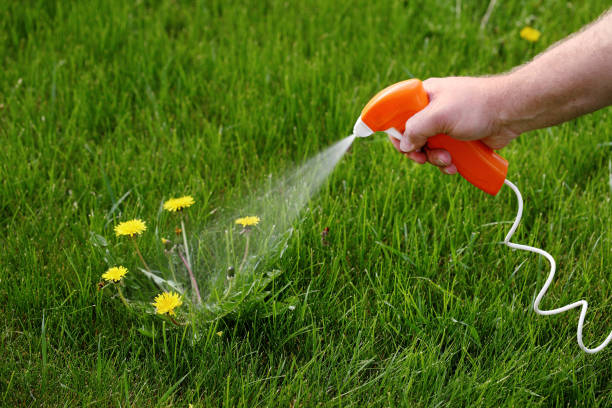HERBICIDES
what is herbicides ?
Herbicides can be define as chemicals used to kill or control unwanted plants,
known as weeds.Some herbicides are used before planting (pre-emergent)
to prevent weeds from growing, while others are used after weeds have appeared (post-emergent).
TYPES OF HERBICIDES
-
Selective Herbicides: These herbicides target specific types of weeds without harming the desired crops. For example, they might kill broadleaf weeds but leave grasses unharmed.
-
Non-Selective Herbicides: These herbicides kill all plants they come into contact with, used for clearing areas where no vegetation is wanted.
-
Pre-Emergent Herbicides: Applied before the weeds have sprouted, these herbicides prevent weed seeds from germinating and growing.
-
Post-Emergent Herbicides: Used after weeds have already sprouted, these herbicides kill existing weeds.
-
Contact Herbicides: These herbicides kill only the parts of the plant they touch, typically the leaves and stems, and are effective against annual weeds.
-
Systemic Herbicides: These herbicides are absorbed by the plant and travel throughout its tissues, killing the entire plant, including roots. They are effective against perennial weeds.
-
Residual Herbicides: Also known as soil-applied herbicides, these remain active in the soil for a period, providing ongoing weed control.
-
Organic Herbicides: Made from natural substances, these herbicides are less harmful to the environment and can be used in organic farming.
-
Synthetic Herbicides: These are chemically manufactured and widely used for their effectiveness and reliability in conventional farming.
-
Selective Grass Herbicides: Specifically target grass species without affecting broadleaf plants, useful in crops like soybeans or tomatoes.
IMPORTANCE OF HERBICIDES
-
Herbicides help quickly and effectively eliminate weeds,
saving time and labor for farmers and gardeners.
-
By reducing competition from weeds, herbicides
help crops grow better and produce more food.
-
Using herbicides means less need for tilling the soil, which can help preserve soil structure and reduce erosion.
-
Herbicides provide reliable weed control, ensuring that crops can grow without significant interference from weeds.
-
Herbicides can be more cost-effective than manual weeding, especially on large farms.
-
By controlling weeds, herbicides ensure that crops receive the maximum available nutrients, water, and sunlight.
-
Some weeds can host pests and diseases that affect crops. Herbicides help reduce these risks by eliminating the weeds.
-
Reducing the need for manual weeding frees up labor for other important farming tasks.
-
Some crops are genetically modified to tolerate certain herbicides, making weed control even more effective and simplifying farm management.
-
Selective herbicides can target specific weeds without harming crops, allowing for precise weed management.
APPLICATION OF HERBICIDES
-
Spraying: Herbicides are mixed with water and sprayed directly onto the leaves of weeds. This method is common for both pre-emergent and post-emergent herbicides.
-
Soil Application: Herbicides are applied directly to the soil to control weeds before they emerge. This is often used with pre-emergent herbicides.
-
Foliar Application: Herbicides are sprayed onto the leaves of plants. This is particularly effective for post-emergent herbicides that need to be absorbed by the plant.
-
Granular Application: Herbicides are applied in a granular form, spread evenly over the soil. Rain or irrigation dissolves the granules, allowing the herbicide to work.
-
Spot Treatment: Herbicides are applied only to specific, targeted areas where weeds are present. This is often used for non-selective herbicides to avoid damaging desirable plants.
-
Broadcast Application: Herbicides are applied evenly over a large area, either by hand or with machinery. This method is used for both pre-emergent and post-emergent herbicides.
-
Wicking or Wiping: Herbicides are applied using a wick or cloth that wipes the herbicide onto the weeds. This method is useful for treating weeds among crops without harming them.
-
Injection: Herbicides are injected directly into the soil near the roots of the weeds or into the plant itself. This method is used for controlling deeply rooted perennial weeds.
-
Aerial Application: Herbicides are sprayed from an aircraft, suitable for large fields or difficult-to-reach areas. This method is efficient but requires precise application to avoid drift.
-
Drip Irrigation: Herbicides are mixed with water and delivered through a drip irrigation system. This method ensures the herbicide reaches the soil directly around the plants.
RISK OF USING HERBICIDES
-
Herbicides can contaminate soil, water, and air, harming plants, animals, and ecosystems.
-
Exposure to herbicides can cause health problems in humans, including skin irritation, respiratory issues, and long-term diseases like cancer.
-
Herbicides can accidentally harm plants that are not weeds, including crops and beneficial plants.
-
Overuse of herbicides can lead to weeds becoming resistant, making them harder to control over time.
-
Herbicides can run off into rivers, lakes, and groundwater, affecting drinking water and aquatic life.
-
Frequent herbicide use can harm soil organisms and reduce soil fertility over time.
-
Herbicides can negatively impact birds, insects, and other wildlife, disrupting ecosystems.
-
Herbicides sprayed on fields can be carried by the wind to nearby areas, affecting non-target plants and ecosystems.
-
Herbicide residues can remain on crops, potentially entering the food chain and affecting food safety.
-
Over-reliance on herbicides can be expensive for farmers, particularly if resistance leads to the need for more or stronger herbicides.

